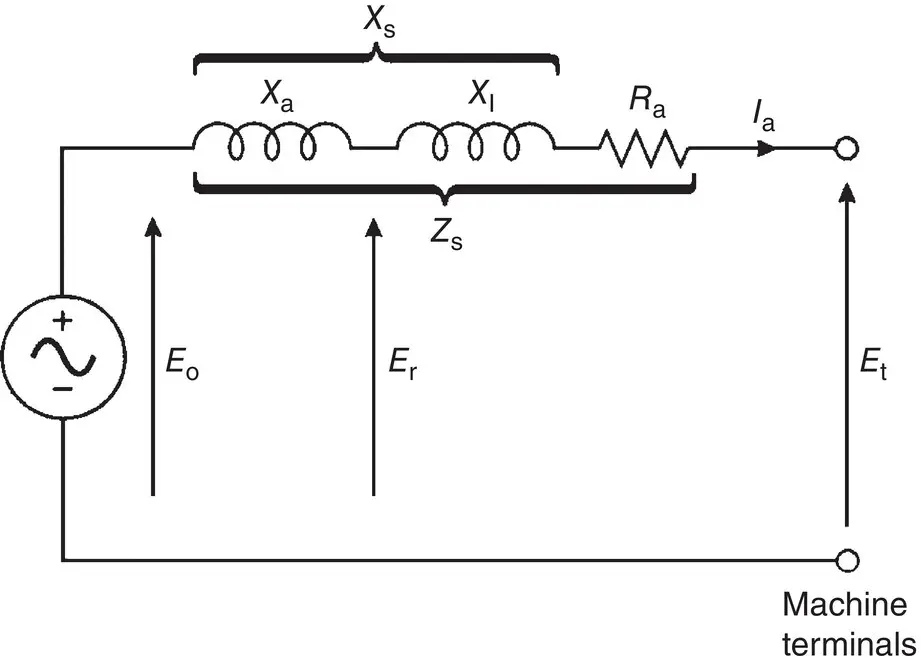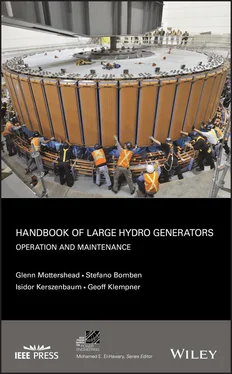
Figure 1.7-6One‐line representation of the circuit shown in Figures 1.4-1and 1.4-2.

Figure 1.7-7Steady‐state equivalent circuit of a synchronous machine.
The simple equivalent circuits of Figure 1.7-8suffices to determine the steady‐state performance parameters of the synchronous machine connected to a power grid. These parameters include voltages, currents, power factor, and power angle. The regulation of the machine can be easily found from the equivalent circuit for different load conditions by using the regulation formula:

For a detailed review of the performance characteristics of the synchronous machine, in particular the hydro generator, the reader is referred to Chapter 4.
Note: Regulation in a generator indicates how the terminal voltage of the machine varies with changes in load. When the generator is connected to an infinite bus (i.e. a bus that does not allow the terminal voltage to change), a change in load will affect the machine's output in a number of ways. (See Chapter 4for a discussion of this topic.)
Current flows through the machines conductors generating heat (a loss). However, there are a number of other sources within a working synchronous generator that produce heat and, thus, losses. The following is a list of some of those sources of losses:
I2R losses of stator winding
I2R losses of rotor winding
Core loss
Stray load loss
Excitation system loss Figure 1.7-8Steady‐state equivalent circuit and vector diagram. (a) Generator operation and (b) motor operation.
Windage and Friction loss
Ventilation and cooling loss
In determining I 2 R losses, the resistance of windings should be corrected to the reference temperature. During the commissioning tests for a generator, the OEM may use a common reference temperature of 75 °C. When calculating the actual losses at a specific temperature, then the resistance at 75 °C must be converted to the resistance at the desired temperature.
1.7.6.1 Stator Winding I2R Loss
The stator winding I 2 R loss is the sum of the I 2 R losses in all of the stator winding current paths. The I 2 R loss in each current path shall be the product of its resistance in ohms as measured with direct current and the square of its current in amperes.
The rotor winding I 2 R loss shall be the product of the measured resistance in ohms of the rotor winding and the square of rotor current in amperes.
The core loss shall be taken as the difference in power required to drive the machine at normal speed when separately excited to produce a voltage at the terminals corresponding to the rated voltage at open circuit, and the power required to drive the unexcited machine at the same speed.
The stray load loss is determined by subtracting the stator winding I 2 R loss at a specific value of stator current from the short circuit loss at the same value of stator current. The short circuit loss shall be taken as the difference in power required to drive the machine at normal speed, when separately excited to circulate current in the stator winding with its terminals shorted, and the power required to drive the unexcited machine at the same speed. The stator winding I 2 R loss shall be calculated for the temperature of the winding during the short circuit test.
1.7.6.5 Excitation System Losses
These losses are the total of electrical and mechanical losses in the equipment supplying excitation. They shall include the exciter, voltage regulator, and associated devices comprising the excitation system of the synchronous machine. Where common equipment is provided in the excitation system for two or more machines, the common equipment loss shall not be included in the evaluation of the synchronous machine efficiency. Motor loss shall be included if a unit motor‐generator exciter set is used; if a unit rectifier is used, the rectifier and rectifier transformer losses shall be included. Include collector electrical brush contact voltage drop loss if applicable.
1.7.6.6 Friction and Windage Loss
The friction and windage loss, including brush mechanical friction, is the power required to drive the unexcited machine at rated speed with the brushes in contact, deducting that portion of the loss which results from
1 forcing the air through any part of the ventilating system that is external to the machine and cooler (if used);
2 the driving of direct‐connected flywheels or other direct‐connected apparatus.
3 In the case of machines furnished with a complete set of bearings, only that portion of the friction and windage loss produced by the bearing load due to the generator or generator/motor itself shall be included. In the case of machines not furnished with a complete set of bearings, only that portion of the friction and windage loss associated with the equipment supplied with the generator or generator/motor shall be included. Where losses are apportioned between equipment or between manufacturers, the method of allocation of the losses shall be subject to agreement between the manufacturer and purchaser.
1.7.6.7 Ventilating and Cooling Loss
This loss includes any power required to circulate the cooling medium through the machine and cooler (if used) by fans or pumps that are driven by external means (such as a separate motor), so that their power requirements are not included in the friction and windage loss. The power consumption of a separate blower system used for a specific unit and necessary for continuous operation of the unit shall be included.
In the following chapters, these losses and their origin, control, and consequences to the machine's design and operation will be covered in detail.
1 1. Sarma, M. S. (1986). Electric Machines: Steady‐State Theory and Dynamic Performance, St. Paul, MN, West Publishing Company.
2 2. Walker, J. H. (1952). Operating characteristics of salient‐pole machines. Proceedings of the IEE – Part II: Power Engineering 100(73), 13–24.
3 3. Neidhofer, G. (1992). The evolution of the synchronous machine. Engineering Science and Education Journal 1(5), 239. Asea Brown Boveri.
4 4. IEEE (2006). IEEE Std C50.12‐2005: IEEE Standard for Salient‐Pole 50 Hz and 60 Hz Synchronous Generators and Generator/Motors for Hydraulic Turbine Applications Rated 5 MVA and Above. New York, IEEE.
1 Say, M. G. (1978). Alternating Current Machines, Pitman Publishing.
Конец ознакомительного фрагмента.
Текст предоставлен ООО «ЛитРес».
Прочитайте эту книгу целиком, купив полную легальную версию на ЛитРес.
Читать дальше














